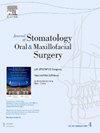Full endoscopic submandibular gland excision through the retroauricular hairline approach: A cohort study
IF 1.8
3区 医学
Q2 DENTISTRY, ORAL SURGERY & MEDICINE
Journal of Stomatology Oral and Maxillofacial Surgery
Pub Date : 2024-12-04
DOI:10.1016/j.jormas.2024.102186
引用次数: 0
Abstract
Introduction
Submandibular gland (SMG) excision can be achieved by conventional approach (Conv) through a cervical incision or endoscopic surgery (Endo). The aim of this study was to propose a new concept and technique of full endoscopic SMG excision through the retroauricular hairline incision and investigate its safety and feasibility.
Materials and methods
A total of 141 patients with SMG diseases treated at our department from 2021 to 2024 were retrospectively enrolled in the Endo group (n = 74) and the Conv group (n = 67). Interested variables included age, sex, pathological diagnosis, incision length, intraoperative bleeding, operation duration, hospitalization stay, complications, and aesthetic satisfaction score. SPSS software 26.0 and G power 3.1.9 were used for analysis.
Results
There were no significant differences between the two groups in age, sex, follow-up period, pathological type, incision length or postoperative complications. Significant differences were found for the amount of bleeding [Endo: 12.5 (10.0) mL; Conv: 20.0 (20.0) mL, P < 0.001] and aesthetic satisfaction score [Endo: 8.8 ± 1.3; Conv: 7.5 ± 1.8, P < 0.001]. The operation duration of the Endo group was longer for early cases [Endo: 110.0 (27.5) min; Conv: 87.0 (40.0) min, P < 0.001], yet there was no significant difference from the thirtieth case [Endo: 85.0 (20.0) min; Conv: 89.0 (52.5) min, P = 0.894]. No recurrence of SMG diseases occurred during the follow-up period.
Discussion
Full endoscopic SMG excision through the retroauricular hairline approach results in less intraoperative bleeding, invisible scars, and greater patient satisfaction, achieving ideal clinical and cosmetic outcomes.
经耳后发际入路的全内窥镜颌下腺切除术:一项队列研究。
下颌骨腺(SMG)的切除可以通过传统的方法(Conv)通过颈部切口或内窥镜手术(Endo)来实现。本研究的目的是提出经耳后发际切口全内镜SMG切除的新概念和新技术,并探讨其安全性和可行性。材料与方法:回顾性研究2021 - 2024年在我科治疗的SMG疾病患者141例,分别分为Endo组(n = 74)和Conv组(n = 67)。感兴趣的变量包括年龄、性别、病理诊断、切口长度、术中出血、手术持续时间、住院时间、并发症和审美满意度评分。采用SPSS 26.0软件和G power 3.1.9进行分析。结果:两组患者在年龄、性别、随访时间、病理类型、切口长度、术后并发症等方面差异无统计学意义。出血量差异有统计学意义[远藤:12.5 (10.0)mL;Conv: 20.0 (20.0) mL, P < 0.001),审美满意度评分[远藤:8.8±1.3;Conv: 7.5±1.8,P < 0.001]。Endo组早期病例手术时间更长[Endo: 110.0 (27.5) min;Conv: 87.0 (40.0) min, P < 0.001],但与第30例无显著差异[Endo: 85.0 (20.0) min;Conv: 89.0 (52.5) min, P = 0.894]。随访期间无SMG疾病复发。讨论:经耳后发际入路的全内镜SMG切除术中出血少,疤痕不可见,患者满意度高,达到理想的临床和美容效果。
本文章由计算机程序翻译,如有差异,请以英文原文为准。
求助全文
约1分钟内获得全文
求助全文
来源期刊

Journal of Stomatology Oral and Maxillofacial Surgery
Surgery, Dentistry, Oral Surgery and Medicine, Otorhinolaryngology and Facial Plastic Surgery
CiteScore
2.30
自引率
9.10%
发文量
0
审稿时长
23 days
 求助内容:
求助内容: 应助结果提醒方式:
应助结果提醒方式:


